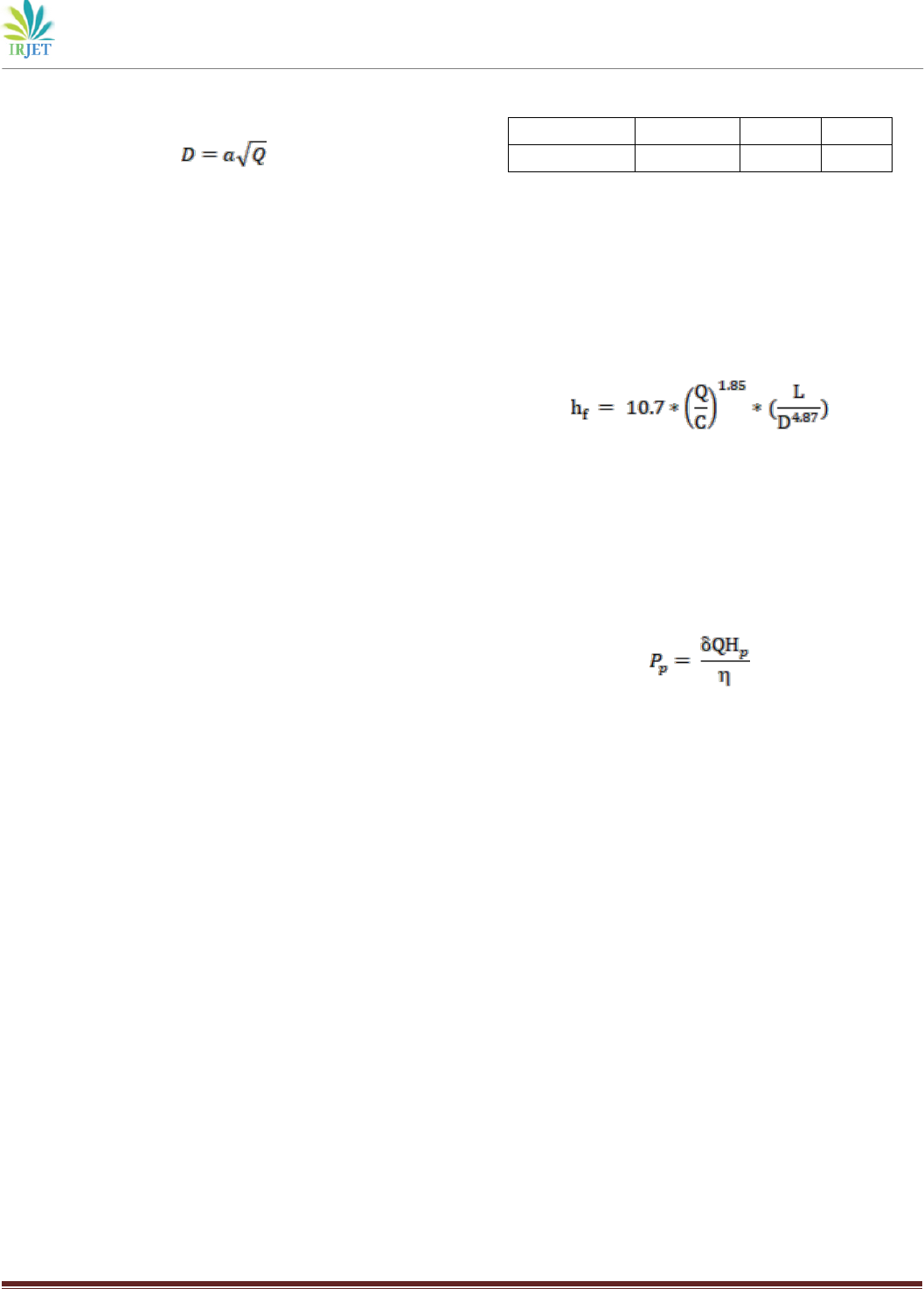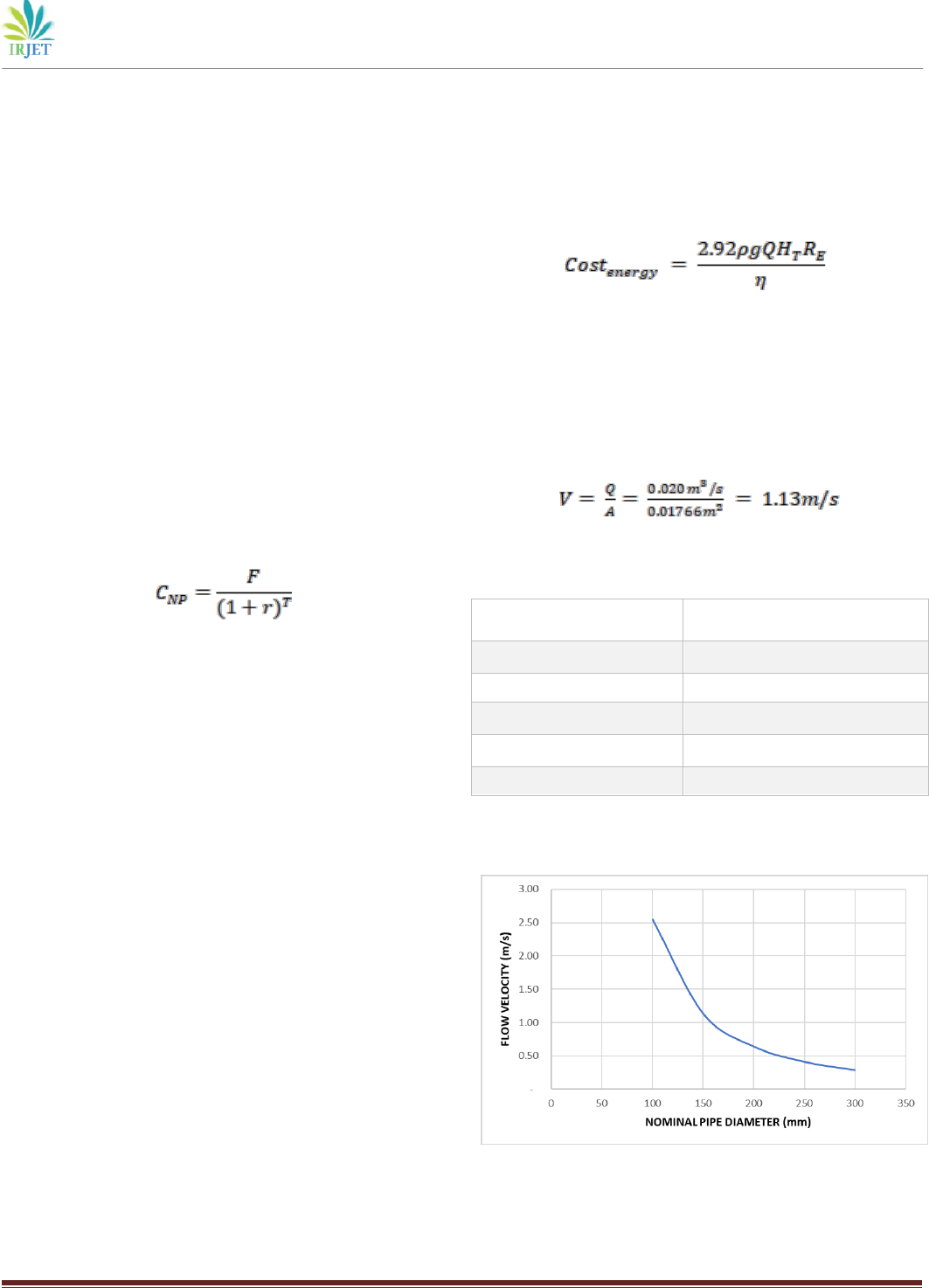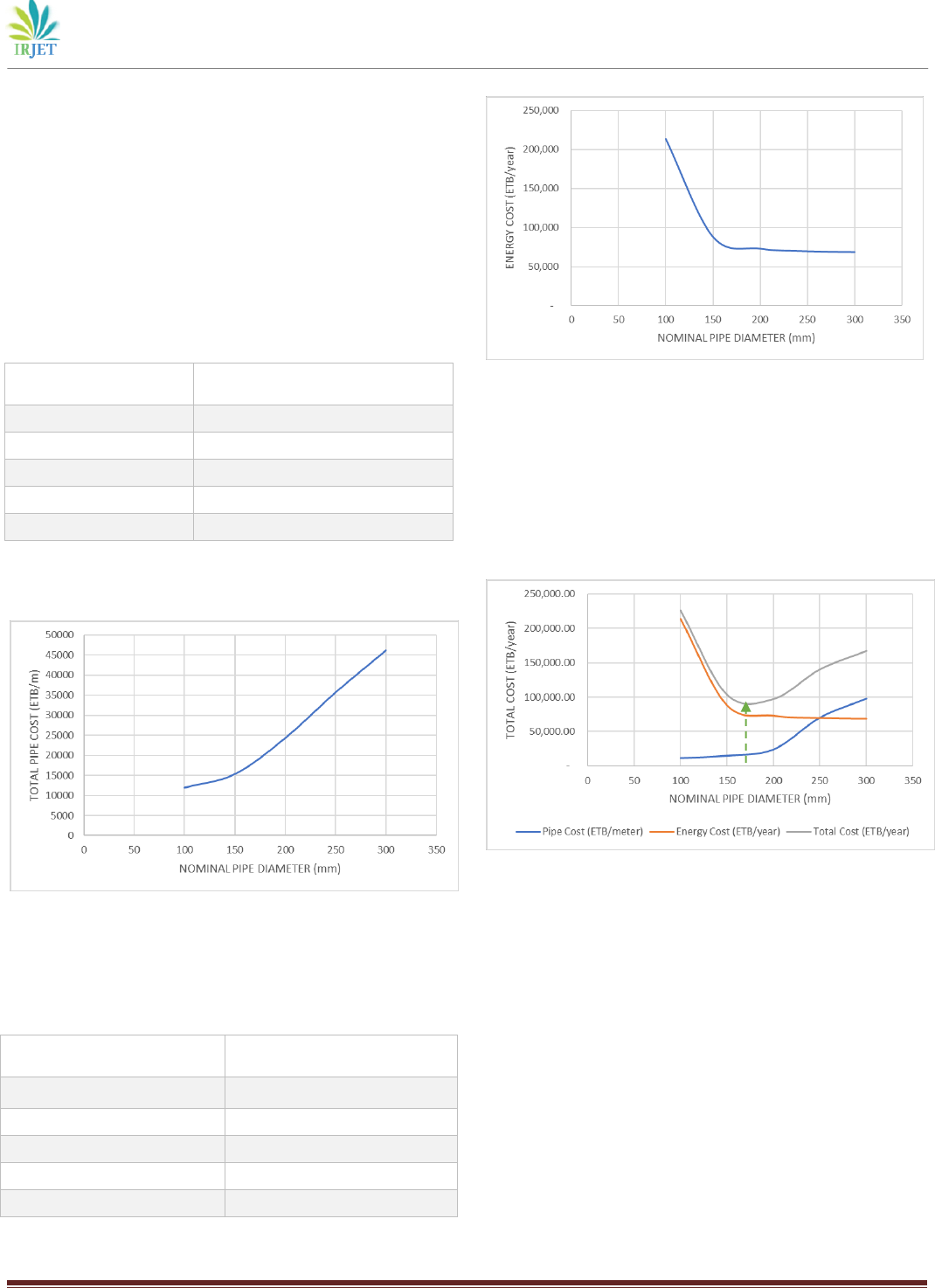
International Research Journal of Engineering and Technology (IRJET) e-ISSN: 2395-0056
Volume: 08 Issue: 02 | Feb 2021 www.irjet.net p-ISSN: 2395-0072
© 2021, IRJET | Impact Factor value: 7.529 | ISO 9001:2008 Certified Journal | Page 1173
Evaluation of Methodologies for Determination of Economical Pipe
Diameter of Water Pumping Mains
Gebremedhin Mulatu Gessa
Lecturer, Department of Hydraulics and Water Resources Engineering, Wolaita Sodo University, Ethiopia
---------------------------------------------------------------------***---------------------------------------------------------------------
Abstract - Pipes represent a large proportion of
capital invested in water pumping system undertakings
and proper sizing of the pumping main play an
important role in the overall design of any water
supply system. Therefore, determination of pipe
diameter for pumping mains shall have to be
judiciously selected not only from the point of view of
its hydraulic performance but also from the point of
view of its installation and operation costs necessary to
ensure the required function and performance
throughout its designed lifetime. It should also be
designed to reduce pumping costs through economical
combination of pipe diameters, pumping head and
pump requirements. It is therefore, the purpose of this
paper to analyse the methodologies commonly used for
optimization and determination of economical pipe
diameter of a simple water pumping main taking Metti
Town Water Sypply system as a case study area with
the expectation that the knowledge of the
interdependence of the variables involved might
produce a better understanding of the problem and,
perhaps, lead to better designs.
Key Words: Water supply system, Water pumping main,
Optimization, Economical pipe diameter, Water pumping
head
1. INTRODUCTION
The essential design objectives for pumping mains are
assessing hydraulic capacity under various flow conditions,
facilitating best management practices in the operation of
the pumping system, and providing for the buried
infrastructure’s long-term physical resiliency. It therefore
requires the appropirate dimensioning of pipe diameter in
addition to the selection of materials that provide the highest
efficiency. The appropriate dimensioning depends on the
determination of water flow velocity, flow rate, pipe
diameter and head loss in the pumping main. Since flow rate
is a parameter determined in the project demand analysis,
three parameters remain to be defined. However, there are
only two equations available for this task, the mass and
energy conservation equations, which are functions of flow
rate and pipe diameter, meaning the dimensioning is a
hydraulically undetermined problem.
Pipe network optimization problems can be classified in
numerous ways. The two most meaningful classifications
concern whether the flow distribution is initially fixed (fixed
versus variable flow pattern), and whether the system's
energy is provided by gravity or pumping (gravity versus
pumped systems).
In gravity systems, the least costly piping system will
dissipate all excessive head thus keeping pipe size, and
hence cost, to a minimum. In pumped systems, the available
head is not fixed but can be altered by changing pump head
with the associated changes in energy and pumping
equipment costs.
2. MATERIALS AND METHODS
2.1. Methods Used for Determination of Economical
Diameter
In history, different reserchers have come to pipe
optimization models that rely on some technique from the
field of operations and researchs to find optimal solutions. In
order to apply the solution technique, however it is
necessary to simplify the field problem to make it fit the
solution technique and was impossible to incorporate
reliability considerations into design in an unarbitrary and
computationally efficient manner. These methodologies have
traditionally been guided by rule of thumb that includes
different hydraulic factors such as flow velocities, water
pressure and flow conditions for different combination of
pipe diameters.
Now a days, the economical pipe size for pumping main can
be computed using either computer aided rigorous pipe
optimization analysis or by adopting empirical formula
proposed by various scholars.
2.2. Methods Using Empirical Equations
Several authors have published formulae and nomographs
for the estimation of the economic pipe diameter, Genereaux
(1937), Peters and Timmerhaus (1968) (1991), Nolte (1978)
and Capps (1995). Dupuit (1854) proposed that the
economic pipe diameter could be expressed by:
Where: D is the economic pipe size; k is a parameter that
depends, among others, on the costs of the material,
transportation, manhour, electric power, and system
operation and maintenance; and Q is the required flow rate.
Dupuit suggested a value of 1.60 for k, based on the prices of
coal, pipes, manpower and services at that time.
Other famous formulation which is dominantly practiced in
Ethiopia for the calculation of the economic pipe diameter is

International Research Journal of Engineering and Technology (IRJET) e-ISSN: 2395-0056
Volume: 08 Issue: 02 | Feb 2021 www.irjet.net p-ISSN: 2395-0072
© 2021, IRJET | Impact Factor value: 7.529 | ISO 9001:2008 Certified Journal | Page 1174
Lea’s emperical formula (Garg, S. K.). Lea’s equation is
expressed as;
Where; D is economical diameter in meters, a is coefficient
ranging from 0.97 to 1.22 and Q is the amount of water to be
pumped in cubic meter per second. This relation gives
optimum flow velocity varying between 0.8 to 1.35 meter
per second.
2.3. Rigorous Economic Analysis
In rigorous economic analysis, the total cost of pipe and
pumping are worked out at different assumed velocities and
a graph plotted between the annual cost and the size of the
pipe. This analysis requires the flow in the pipe is known
beforehand and finding the most economical combination of
pumping capacity, pumping main diameter and pumping
head to at the lowest annual cost.
For a given discharge of water to be pumped there are two
options to be considered for the economical determination
of the pipe diameter. In one hand it can be done through a
pipe of large diameter at low velocity or in the other hand
through a pipe of small diameter at high velocity. Using a
large pump will unnecessarily add to the cost of the pipe and
if the diameter of the pipe is kept low, the velocity of flow
will have to be measured, which will increase frictional loss
and will also require more power for pumping thereby
increasing the cost of pumping.
An optimum pipe diameter shall be worked out which will
provide an economical pumping of the required quantity of
water. The economical diameter therefore, is the one which
minimizes the total cost meaning, investment cost of pipes
(placement and installation costs), cost of pump and energy
cost of operation (operation and maintenance costs).
Therefore, the total cost of pumping main depends mainly on
the cost of the pipe, the pump and construction of the
pumping station, and the cost of the energy required for the
pumps to work during the entire lifespan of the system.
3. METHODOLOGY
3.1. Case Study: Definition of Project Conditions
For the evaluation of the methods discussed above, Metti
town water supply, sanitation and hyegine project pumping
system located in Gambella Regional State, Ethiopia, is
considered. The porject consists of pumping water to the
350m
3
service reservoir with a design discharge of 20Lit/s
from the well field. For the case study, the pipe material is
selected to be Ductile Cast Iron (DCI) pipe.
The follwing data summarized in the table below is used for
the analysis in which Q is the project flow in cubic meters
per second, L is the cummulative length of pumping main in
meters and H is static head of the systems in meters.
Table 1 Project parameters
Source
Q (Lit/sec)
L (m)
H (m)
Borehole (BH)
20
4863.58
183.75
The objective here is to determine what type of pipe size
should be installed for minimum total annual cost. This can
be achived either by using empirical approch or rigorous
economic method meaning, calculate the total annual cost as
a function of the summation of cost of pipe per year and cost
of pumping per year.
For the determination of dynamic head of the pumping
system, Hazen-Williams equaiton is adopted as follows;
Where C is coefficient of roughness for DCI pipe (130), g is
acceleration due to gravity (9.81m/s
2
) and D is the
economical diameter of pumping main(m). Minor head
losses due to valves and fittings is taken to be 5% of head
loss due to friction.
Taking the calculated duty point of pumps; Pump
discharge(Q) and total head (H
T
) & assumed value of overall
pump and motor efficiency η, the required pump and motor
power is calculated using the following formula:-
Where, is specific gravity of water (9.81KN/m
3
), Q is the
design discharge to be pumped (m
3
/s), H
p
is the total
pumping head (m) and is efficiency of the pump (0.65)
Assumptions
The following assumptions hold in the present approach for
the economic pipe size analysis.
For evaluation of cost of pipe and pumping, water flow
velocity is taken to be in the range of 0.8m/s and 2m/s
Acutal present prices of Ethiopian market is considered
for the cost of pipe, pump, installation, operation and
maintenance and energy.
Electricity as a source of energy and its local prices are
used in this paper for the evaluation of the cost of
energy. The price of electricity is 0.5 Ethiopian Birr
(ETB) per kWh for households and 0.816ETB per kWh
for businesses which includes all components of the
electricity bill such as the cost of power, distribution and
taxes.
3.2. Economical Pipe Diameter Calculation
Based on the methods of analysis discussed in previous
paragraphs the empirical formula proposed by two scholars
and rigorous economic analysis using the annual cost of pipe
and energy as the main factors is used for evaluation of
determination of economical pipe diameter of the case
project.

International Research Journal of Engineering and Technology (IRJET) e-ISSN: 2395-0056
Volume: 08 Issue: 02 | Feb 2021 www.irjet.net p-ISSN: 2395-0072
© 2021, IRJET | Impact Factor value: 7.529 | ISO 9001:2008 Certified Journal | Page 1175
Empirical Analysis
In this analysis, inserting the values of design flow directly
from the water demand analysis to the equation proposed
and claculating for both upper and lower values of the
costant is calculated. Then, market available pipe diameter
size laying in the range of calculated higher and lower sizes
is taken as to be the economical pipe diameter that will
inreturn minimizes the total annual cost of the system. The
flow velocity in the economical pipe diameter calculated
shall also be calculated for its hydraulic feasibility.
Cost Functions of Rigorous Economic Analysis
The rigorous calculations in this research cover the cost of
pipes, annual energy and maintenance. According to
Prabhata K. Swamee and Ashok K. Sharma (2008), the
above-mentioned types of costs cannot be simply added to
find the overall cost or life-cycle cost. These costs have to be
brought to the same units before they can be added. In net
present value analysis method, the current value of the
infrastructure can be calculated for the known infrastructure
associated future costs using a suitable discount rate. The
net present capital cost (P
NC
) of a future expenditure can be
derived as
Where F is future cost, r is discount rate, and T is the
analysis period.
Pipe Cost
It is understood that various pipe sizes are commercially
availabe and the cost is calculated collecting price data of
each pipe sizes. The cost of fixtures and appurtenances are
assumed to be 10% of the cost of the pipeline. (Samra and
Essery, 2003). The cost of completed pipeline, meaning
transportation, excavation and installation cost is also
calculated taking 5% of the cost of the pipeline.
Cost of Pump and Pumping Station
Different pump models usually have similar cost since the
group and stage configurations depend on the variability of
the demand and not on the pipe features. The cost of the
pumping station is not of significance to be worked out as a
separate function and therefore, is not considered in this
paper.
Energy Cost
The cost of energy depends mainly on the variables such as
the volume of water to be pumped, the total pumping head,
the pump efficiency and also the velocity of flow adopted for
the given project. The pumping head is dependent on the
pipe size for the fact that the cost of energy decreases with
increasing pipe size due to reduced headloss and, therefore,
results in reduced pumping head and power consumption.
The annual recurring cost of energy consumed in
maintaining the flow depends on the discharge pumped and
the total pumping head H
T
produced by the pump. An
electrical cost could be calculated by multiplying the pump
size equation with operation hours. The calculated pumping
hour for the system is 8hrs/day or 2920hrs/yrar.
Multiplying the power by the number of pumping hours in a
year and the rate of electricity per kilowatt-hour, R
E
, the
annual cost of energy C
e
consumed in maintaining the flow
could be written as follows.
4. RESULTS AND DISCUSSION
4.1. Dupit and Lea’s Empirical Equation
For design discharge of 20Lit/s, Lea’s emirical equation gives
the economic pipe size as 137.18mmm for lower coefficient
value of 0.97 and 172.53mm for higher coefficient value of
1.22. Market available pipe size for calculated diameter sizes
in between 137.18mm and 172.53mm is 150mm. Now,
checking the velocity of flow through the pipe using
continuity equation,
Table 2: Pipe Diameters and Coresponding Flow
Velocity (m/s)
Nominal Pipe Diameter
(mm)
Velocity Through the Pipe
(m/s)
100
2.55
150
1.13
200
0.64
250
0.41
300
0.28
Figure 1: Variation of Flow Velocity with Pipe
Diameter
From the calculated result and the figure 1 above, it can
clearly seen that the velocity of flow through 150mm
diameter pipe size gives optimum value that meets the
design fow velocity and therefore, pipe size of DN150mm
can be selected to be the economical pipe diameter.

International Research Journal of Engineering and Technology (IRJET) e-ISSN: 2395-0056
Volume: 08 Issue: 02 | Feb 2021 www.irjet.net p-ISSN: 2395-0072
© 2021, IRJET | Impact Factor value: 7.529 | ISO 9001:2008 Certified Journal | Page 1176
Using parameter k value as 1.60, the Dupit expression for
economical pipe diameter D=k√Q results in the pipe size of
226.26mm. Taking market avilable diameter of 200mm and
250mm and checking the velocity of flow, pipe diameter
results in 0.32 for 200mm 0.8m/s for 250mm pipe diameter.
4.2. Rigorous Economic Analysis
4.2.1. Pipe Size and Pipe Cost Relationship
It can be clearly seen from the table below that pipe cost
increases with increase in pipe diameter.
Table 3: Pipe Diameters and their Corresponding
Costs (Ethiopian Birr, ETB)
Nominal Pipe Size
(mm)
Total Pipe Cost
(ETB/Meters)
100
11,884
150
15,294
200
24,284
250
35,660
300
46,124
Figure 2: Variation of Pipe per meter Cost with Pipe
Diameter
4.2.2. Annual Energy Cost and Piipe Size
Relationship
Table 3: Pipe Diameters and Coresponding Annual
Energy Cost (ETB/year)
Nominal Pipe Diameter
(mm)
Csot of Energy
(ETB/year)
100
213,718
150
88,246
200
73,004
250
69,702
300
68,713
Figure 3: Variation of Annual Energy Cost with Pipe
Diameter
4.2.3. Total Annual Cost and Piipe Size Relationship
From the annual pipeline cost and energy cost relationships,
we have clearly seen when the larger the pipe diameter
becomes, the greater will be the capital charges. In addition,
the cost of energy goes down rapidly as the pipe size
increases resulting in pressure drop.
Figure 4: Total Annual Cost Versus Nominal Pipe
Diameter
The total cost is obtained by adding, the energy and piping
cost functions which are computed for each pipe size for the
design flow and taking derivative of the new combined
function with respect to diameter. This combination will
create the function representing the total annual cost of the
pipeline. As shown in Figure 4 above, a curve drawn results
in U-shape. The pipe diameter corresponding to this point at
the bottom of the U-shaped curve is the pipe which gives
minimum annual cost and the size at this point can be taken
as the economical pipe diameter.
Therefore, it can be seen from the graph minimum annual
total cost lays at coresponding pipe size of around 170mm.
But this pipe size is not market available and has to be
decided to be taken from either 150mm or 200mm checking
for the validity of meeting the design flow velocity criteria.
5. CONCLUSION
The aim of this study was to reach the economical pipe
diameter of the simple pumping main of Metti town water
supply, sanitation and hyegine project using empirical

International Research Journal of Engineering and Technology (IRJET) e-ISSN: 2395-0056
Volume: 08 Issue: 02 | Feb 2021 www.irjet.net p-ISSN: 2395-0072
© 2021, IRJET | Impact Factor value: 7.529 | ISO 9001:2008 Certified Journal | Page 1177
equations and rigorous econmic analysis. The study shows
both methodologies resulted in slightly similar values of
economic pipe diameter.
The empirical equations preseneted by two scholars Dupit
and Lea uses flow of water and constants to reach the
economical pipe diameter checking for design flow velocity
range. In rigorous economic analysis, the relationship
between pipes and pumps creates many economic trade-offs
to consider. While a smaller pipe has lower capital costs, the
larger pump required to overcome the additional pressure
losses will cost more (both in capital and long-term
operating costs). Meanwhile, a larger pipe costs more
upfront, but enables lower operating costs as the pump does
not need to work as hard. Even with this simple example, it is
clear that there is a point where a perfectly sized pump
paired with a perfectly sized pipe can minimize system costs.
This point can be seen visually in Figure 4. Each pump-pipe
pair is informed by the essential design requirements,
placing each potential component pair on equal technical
footing.
In complex water pumping mains, the operating costs are
made up of many complex functions. Likewise, cost functions
for the fixed capital investment are very complex and also
made up of several factors. Thus, the resultant total cost
function may not be a simple curve, and it could be a
polynomial function with many local minimums and one
global optimal minimum total cost. One could understand
why this problem could be impossible to complete by hand
without using several risky assumptions.
Thus, it is essential for engineers to design the pumping
mains with precise economic specifications. The work
associated with operating a pump and the initial cost of pipe
are interrelated by the diameter of the pipe. Therefore,
designing a pipe with the appropriate diameter is crucial to
the optimization of the pumping mainline.
REFERENCES
[1] Gessler, J. Walski, T.M. Water Distribution System
Optimization; Technical Report EL-85-11, US Army
Engineer Waterways Experiment Station Vicksburg
Miss. USA, 1985.
[2] Malcolm J. Brandt K. Michael Johnson Andrew J.
Elphinston Don D. Ratnayaka, Twort’s Water Supply,
Seventh Edition, Elsevier Ltd. 2017.
[3] Garg, S. K. Water Supply Engineering, 6th ed. Khanna
Publishers, Delhi, India, pp. 287. 1990.
[4] Prabhata K. Swamee, Ashok K. Sharma. Design of Water
Supply Pipe Networks, John Wiley & Sons, Inc, 2008.
[5] FDRE, Minstry of Water Resources. Urban Water Supply
Design Criteria, Addis Ababa, Ethiopia, 2006.
[6] Marriott, Martin, Featherstone, R. E., Nalluri, C., Nalluri &
Featherstone’s civil engineering hydraulics: essential
theory with worked examples. 6th edition, John Wiley &
Sons, Inc., 2016.
[7] AWWA Manual of Water Supply Practices, Steel Pipe: A
Guide for Design and Installation, Fourth Edition, 2004.
[8] Joint Departments of the Army and Air Force USA,
Technical Manual TM 5-813-5/AFM 88-10, Volume 5,
Water Supply, Water Distribution, November 1986.
[9] Sue Ira, Koru Environmental Consultants Ltd, Summary
of life cycle costs for water supply infrastructure
solutions, 2017.
[10] Ethiopian Standards Agency, Compulsory Ethiopian
Standard /CES 161/, Plumbing services of buildings,
First Edition, 2015.
[11] Ashok K. Sharma and Prabhata K. Swamee, Design Life of
Water Transmission Mains for Exponentially Growing
Water Demand, Researchgate Publication, 2004.
[12] International Code Council, Inc, International Plumbing
Code, First Edition, 2009.
[13] Joseph P. Reynolds, Louis Theodore, John S. Jeris,
Handbook of Chemical and Environmental Engineering
Calculations, John Wiley & Sons, Inc., New York, 2002.
[14] Yunus A. Çengel, John M. Cimbala, Fluid Mechanics:
Fundamentals and Applications, McGraw-Hill
Companies, Inc., 2006.
[15] P. Cooper, G Tchobanoglous, Pumpin Station Design,
2008.
[16] Thane Brown, Engineering Economics and Economic
Design for Process Engineers, CRC Press, 2006.
